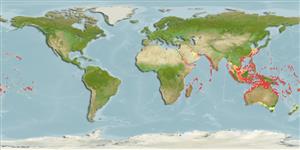Environment: milieu / climate zone / depth range / distribution range
Ecologia
marinhas; estuarina associadas(os) a recifes; intervalo de profundidade 0 - 80 m (Ref. 9710). Tropical; 32°N - 47°S, 24°E - 140°W
Indo-Pacific: Persian Gulf (Ref. 68964), Red Sea and East Africa to the Marquesan and Easter islands, north to southern Japan and the Ogasawara Islands, south to northern Australia and Lord Howe Island; except in Hawaii, where former subspecies C. marginatus is found.
Tamanho / Peso / Idade
Maturity: Lm ? range ? - ? cm
Max length : 140 cm TL macho/indeterminado; (Ref. 90102); common length : 50.0 cm TL macho/indeterminado; (Ref. 11039)
Descrição suscinta
Chaves de identificação | Morfologia | Morfometria
Espinhos dorsais (total) : 0; Espinhos anais: 0; Vértebras: 139 - 146. Flanges on upper and lower lips well developed; 2 rows of teeth in jaws, those of outer row larger; closely set and compressed to form cutting edge; 6th infraorbital pore located close behind and slightly above posterior angle of jaw. Dorsal fin begins over middle of appressed pectoral fin (Ref. 11039, refer to key for other characters). Brownish grey, yellow below and on fins, median fins with narrow black edge, black patch on lower rear edge of eye and on pectorals (Ref. 5323); assumes a pattern of broad dark bands at night (see also Ref. 4538, 1602). Body depth at gill opening 17-23 in TL (Ref. 90102).
Solitary species common on reef flats and seagrass beds of shallow lagoons but ranges to depths of 80 m on outer reef slopes (Ref. 1602). Also found in estuaries (Ref. 5213). Feeds on fish and crustaceans at night, assuming a pattern of broad dark grey bars (Ref. 11441). Minimum depth reported taken from Ref. 86942.
Ciclo de vida ou comportamento de acasalamento
Maturidade | Reprodução | Desova | Ovos | Fecundidade | Larvas
Smith, D.G., 1999. Congridae. Conger eels. p. 1680-1686. In K.E. Carpenter and V.H. Niem (eds.) FAO species identification guide for fishery purposes. The living marine resources of the WCP. Vol. 3. Batoid fishes, chimaeras and bony fishes part 1 (Elopidae to Linophrynidae). FAO, Rome. (Ref. 11039)
Status na Lista Vermelha da UICN (Ref. 130435: Version 2024-1)
Ameaça para os humanos
Harmless
Uso pelos humanos
Pescarias: espécies comerciais; peixe esportivo: sim; Aquário: Espécies comerciais
Ferramentas
Relatórios especiais
Baixar XML
Fontes da internet
Estimates based on models
Preferred temperature (Ref.
123201): 23.7 - 29, mean 27.7 °C (based on 1436 cells).
Índice de diversidade filogenética (Ref.
82804): PD
50 = 0.5000 [Uniqueness, from 0.5 = low to 2.0 = high].
Bayesian length-weight: a=0.00060 (0.00034 - 0.00106), b=3.21 (3.06 - 3.36), in cm total length, based on LWR estimates for this species & Genus-body shape (Ref.
93245).
Nível Trófico (Ref.
69278): 4.3 ±0.5 se; based on diet studies.
Resiliência (Ref.
120179): Baixo, tempo mínimo de duplicação da população 4,5 - 14 anos (Preliminary K or Fecundity.).
Fishing Vulnerability (Ref.
59153): Very high vulnerability (84 of 100).
Nutrients (Ref.
124155): Calcium = 22.3 [12.3, 38.1] mg/100g; Iron = 0.449 [0.264, 0.796] mg/100g; Protein = 19.1 [16.1, 22.1] %; Omega3 = 0.114 [0.052, 0.326] g/100g; Selenium = 49.9 [26.8, 95.7] μg/100g; VitaminA = 67.3 [20.5, 229.8] μg/100g; Zinc = 0.8 [0.6, 1.1] mg/100g (wet weight);
